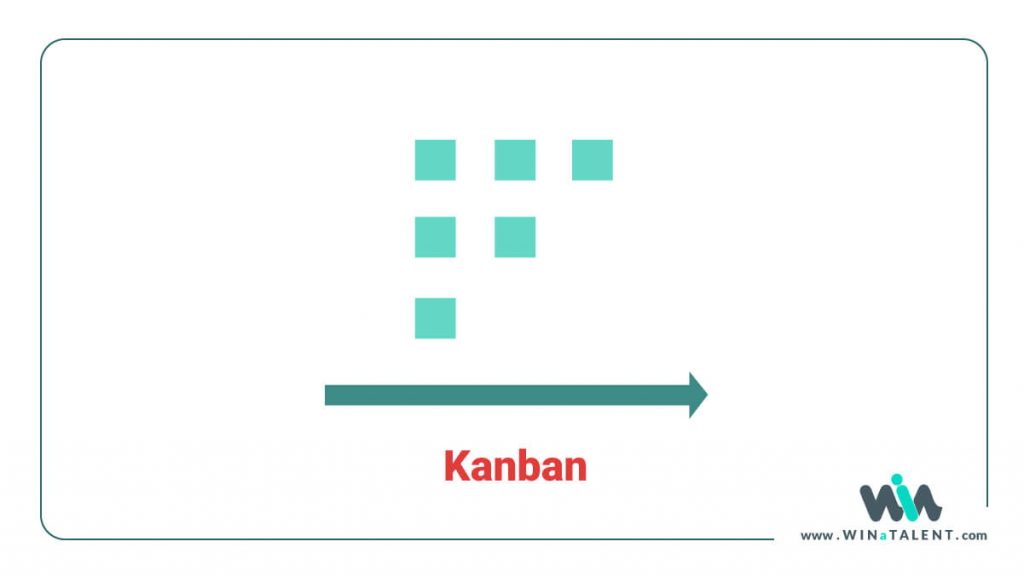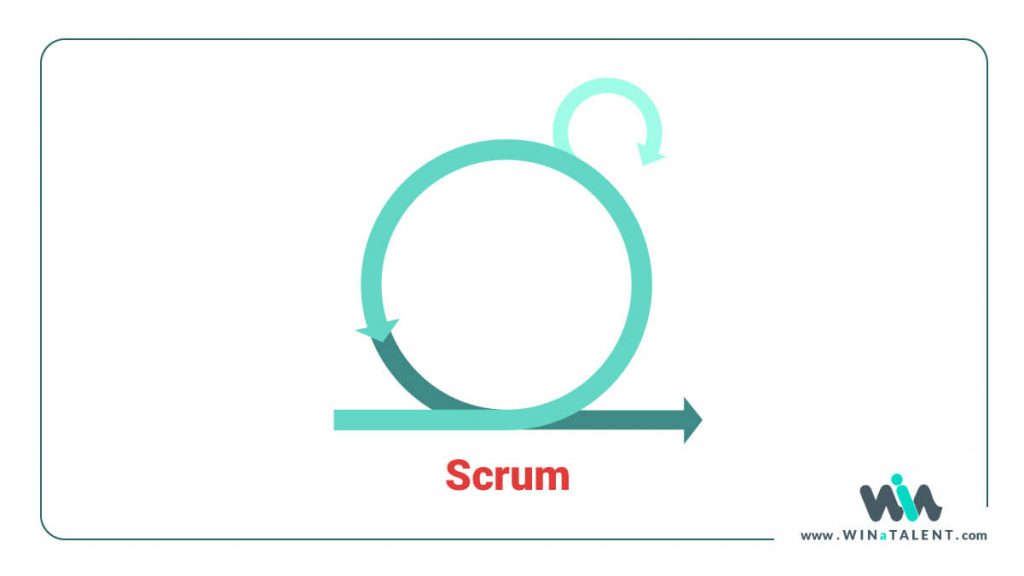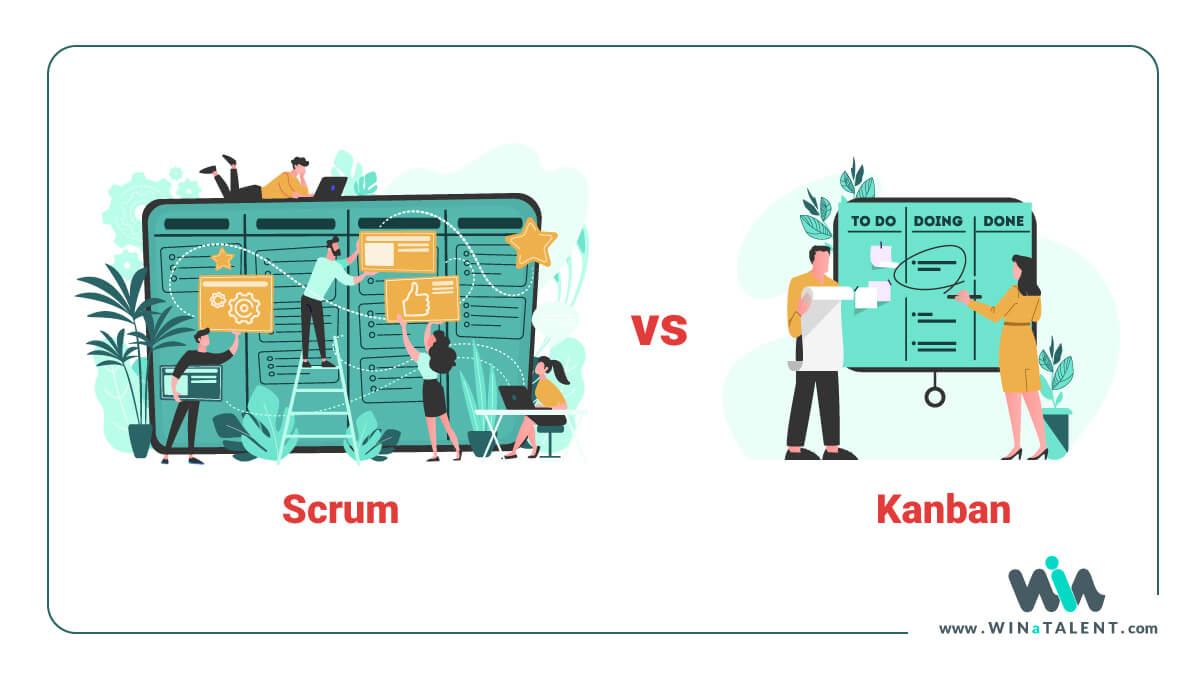Agile methodology is a collaborative, self-organizing, and cross-functional approach to completing work and its requirements and developing a software or an app. Kanban and Scrum are both considered types of Agile.
The goal of project management methodologies is to facilitate the complication of a project and help both the founder and the development team to deliver a better final product. By following a method in the development process, you and your team find the best roadmap to plan, develop, test, launch, support, and maintain a software or application.
Kanban and Scrum use Agile methodology principles discussed on our post about Agile, Waterfall, and RAD, but each implement them in a particular and different way.
What Is Kanban Methodology?

Kanban is translated as “board” or “card” in Japanese.
The methodology first appeared in the 1940s Toyota factory to help with inventory inefficiencies.
But now, Kanban counts as a methodology to manufacture and deliver products just in time.
In Kanban, there are two main aspects: Kanban board, and Kanban cards.
The Kanban board represents the work process, and the Kanban cards represent project details.
Both the board and the cards help with the adjustment of the workflow.
There is a Work in Process (WIP) limitation in Kanban boards that all of the development team should know about.
In the Kanban board, only a particular number of projects should be put in every column. All of the people involved in the production and planning should know about WIP limitations.
For example, a Kanban board can have columns like backlog, progress, test, and done. In each column, there are a particular number of Kanban cards that represent the work in progress. On these cards, the team members can see the work in progress, the job done, etc.
Trello counts as a perfect Kanban board to visualize your work and follow up on the progress.
In Kanban, the workflow needs to be smooth in the whole weekly or monthly schedule. Therefore, if there is a day with more WIP cards in the Kanban board, there is a bottleneck that the managing team needs to solve.
What Are Kanban’s Basic Principles?
- Visualization of the workflow:
Kanban helps with the visualization of the workflow.
In the Kanban board, the columns specify the work stages that a project needs to go through, and the number of cards in each column represents project details.
- Limitation of work in progress:
The number of Kanban cards helps to control and limit the workflow. With this method, the team’s stress level is managed, and the team can follow the schedule to deliver better products.
- Improvement for continuous delivery:
The main reason for following Agile is to deliver products continually; this helps with the feedback cycle and the quality of the final product.
Also, the stakeholders and founders will have a better understanding of the finalized product. This in turn, helps with the continuous improvement of the product.
What Are The Benefits of Kanban?
Simplicity:
Kanban is straightforward to follow and doesn’t need many resources to make it work for any team.
Adaptivity:
You can add Kanban to any other methodology. The team members can adapt to the workflow.
Flexibility:
With limited WIP, the team can manage their time and effort to deliver continuously with more speed.
Efficiency:
Kanban reduces the waste of time and resources with improvement in the workflow.
Incremental changes:
The project adaptation happens because of data visualization that occurs in the Kanban process. The changes and adjustments that occur afterwards are pretty slow with this method; the team’s resistance is reduced, therefore, they adapt to changes better and more accessible.
Versatility:
The Kanban methodology is usable with a variety of teams and even as a co-methodology in development.
What Is Scrum Methodology?

Scrum is an incremental and iterative production process that works creatively with immediate founder-changing needs.
The Scrum team is relatively small in the number of members who are frequently interactive with one another.
Because of the founder’s changing needs, the production team needs to use their creativity to deliver unknown solutions for each step of the production.
Scrum is a methodology primarily focused on the active part of the project.
Each production cycle divides into two weeks Sprints. In these Sprints, the whole production cycle is planned, and the work is prioritized to deliver a product.
In Scrum methodology, there are three leading roles. The Scrum Master, The Scrum team, and the Product Owner.
Scrum Master is not the usual project manager. The Scrum Master is responsible for assigning work, managing schedules, and troubleshooting challenges.
The Scrum team is a team of individuals like programmers, designers, writers, QA testers, etc; who work as a self-led team to deliver the product in a Sprint.
The Product Owner represents the business and the customers of the product.
Both the Scrum Master and the Product Owner help with Sprint plannings and prioritizing the Sprints’ product features and organization.
The product Owner plays an active role in the Scrum methodology. The Scrum Master needs to help with the Sprints’ continuous adaptation to help the development team deliver better, on schedule products.
What Are The Benefits of Scrum?
Adaptivity:
In Scrum methodology, the principle of regular check-ins helps with the methodology’s adaptivity to the process and product. These check-ins, helps to solve the problems and setbacks by identifying them at a fast pace. Therefore, the team won’t be losing precious time or resources.
Visibility:
Both the Scrum team and the product owner can see the production process regularly. They both feel involved, and this visibility helps with their motivation.
Efficiency:
The Agile perspective is to do more work more efficiently. Scrum is also following this aspect.
Both Kanban and Scrum can be helpful methods for your software and/or app development process.
At WINaTALENT, according to your project, we find the best methodology that works best for you. And in our talent pool, we can help you find the talented individuals to set up and deliver the desired product.

It had been a long time that I was looking for a content about Agile management. Went through some books to read but honestly they were so time consuming and I was not sure if I really need to do that. This thread gave me an initial motivation to continue reading about the topic.